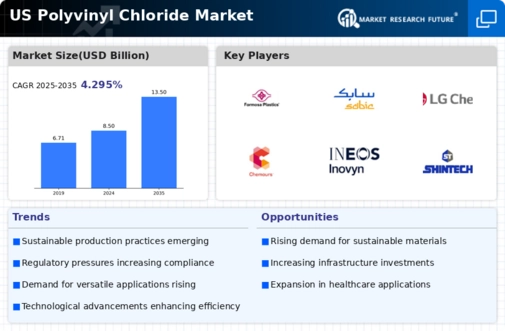The polyvinyl chloride market exhibits a dynamic competitive landscape characterized by a blend of innovation, strategic partnerships, and regional expansion. Key players such as Westlake Chemical Corporation (US), OxyChem (Occidental Petroleum Corporation) (US), and BASF SE (Germany) are actively shaping the market through their distinct operational focuses. Westlake Chemical Corporation (US) emphasizes vertical integration and sustainability, aiming to enhance its production capabilities while reducing environmental impact. OxyChem (Occidental Petroleum Corporation) (US) is strategically investing in advanced manufacturing technologies to optimize its supply chain and improve efficiency. Meanwhile, BASF SE (Germany) is leveraging its global presence to foster innovation in product development, particularly in sustainable PVC solutions. Collectively, these strategies contribute to a competitive environment that prioritizes efficiency and sustainability.
The market structure appears moderately fragmented, with several key players exerting influence over various segments. Companies are increasingly localizing manufacturing to mitigate supply chain disruptions and enhance responsiveness to regional demands. This tactic not only optimizes operational efficiency but also aligns with the growing consumer preference for locally sourced products. The collective influence of these major players fosters a competitive atmosphere where innovation and sustainability are paramount, driving the market forward.
In November 2025, Westlake Chemical Corporation (US) announced the launch of a new line of eco-friendly PVC products designed to meet stringent environmental regulations. This strategic move underscores the company's commitment to sustainability and positions it favorably in a market increasingly driven by eco-conscious consumer preferences. By investing in sustainable product lines, Westlake aims to capture a larger market share while enhancing its brand reputation.
In October 2025, OxyChem (Occidental Petroleum Corporation) (US) unveiled a significant investment in a state-of-the-art manufacturing facility in Texas, aimed at increasing production capacity for PVC. This facility is expected to utilize cutting-edge technology to streamline operations and reduce emissions. The strategic importance of this investment lies in its potential to bolster OxyChem's competitive edge by enhancing production efficiency and meeting the rising demand for PVC in various applications.
In September 2025, BASF SE (Germany) entered into a strategic partnership with a leading technology firm to develop AI-driven solutions for optimizing PVC production processes. This collaboration is indicative of the growing trend towards digitalization within the industry. By integrating AI technologies, BASF aims to enhance operational efficiency and reduce costs, thereby solidifying its position as a market leader.
As of December 2025, the competitive trends within the polyvinyl chloride market are increasingly defined by digitalization, sustainability, and technological integration. Strategic alliances are becoming more prevalent, enabling companies to leverage complementary strengths and enhance their market positions. The shift from price-based competition to a focus on innovation, technology, and supply chain reliability is evident. Moving forward, competitive differentiation will likely hinge on the ability to innovate and adapt to evolving consumer demands, with sustainability at the forefront of strategic initiatives.

















Leave a Comment